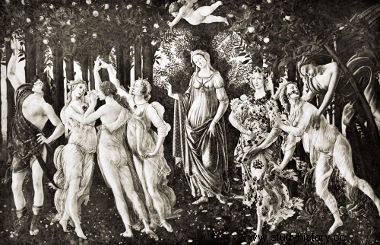
By Me. Cláudio Fernandes
The history of art it is one of the most important disciplines of the Humanities (that is, the area of the humanities). The interpretation and apprehension of the meaning of works of art allows us to have a broader understanding of human existence itself. One of the art historians who came to have great prominence at the turn of the 19th to the 20th century was the German Aby Warburg . For Warburg, the art historian needed to perceive the signs of vital force that every work of art “fossilizes” in its forms.
Just as the archaeologist and paleontologist recompose notions about the life and cultures of the past through vestiges, the art historian should, according to Warburg, identify the survival of the past in the images. In each sculpture, drawing, monument or painting, a movement of life captured by the artist is recorded. If, after the invention of photography and cinema, images receive a more reliable record, before these inventions, artists needed to imprint on canvas, panels or sculptures a notion of movement, of a vital aspect.
In this sense, Warburg developed a new discipline that transcended the domains of simple art history, this discipline became known as iconology (“icon”, image and “logy”, study”), being the concept of survival one of the most important for understanding Warburg's method, as highlighted by the French researcher Georges Didi-Huberman :
“[...] A survival therefore opens the story – what Warburg wanted when he spoke of a 'history of art in the broadest sense' [ wohl zum Boebachtungsgebiet der Kunstgeschichte im weitesten Sinne]:a history of art open to the anthropological problems of superstition, of the transmission of beliefs. An art history informed by the 'psychology of culture' with which Warburg had begun to fall in love with Hermann Usener and Karl Lamprecht.” [1]
This sense of “opening of history” that Warburg speaks of presents a certain “anachronism positive”, that is, a way of perceiving connections between several different historical times in one or more works of art. By conceiving works of art as artifacts that manage to present multiple temporalities, Warburg breaks with the traditional concept of history, characterized by the progressive chronology, typical of modern thinkers, in which each epoch surpasses the previous one, either socially or culturally.
That's why one of Warburg's favorite objects of study was the Renaissance Italian . Warburg wanted to prove that the art of the Renaissance was not a pure and simple rescue of Greco-Roman culture, it was not a “pure” art, from the point of view of historical rescue. It was an “impure” art, in the sense of presenting many “times” and many cultures mixed in a single artistic piece. One of the painters most studied by Warburg was Sandro Botticelli.

The painting “A Primavera”, by Botticelli, was exhaustively studied by Warburg
Warburg even assembled a huge panel with clippings of prints from various paintings from the Renaissance and other artistic movements in order to make a comparative study and apply his method. This panel became known as the Atlas Mnemosyne.
NOTE
[1] DIDI-HUBERMAN, Georges. The surviving image:art history and the time of ghosts according to Aby Warburg . trans. Vera Ribeiro. Rio de Janeiro:Editora Contraponto, 2013 [2002]. P. 69.
